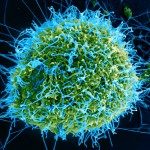Link to Pubmed [PMID] – 24622732
Gene Ther. 2014 May;21(5):529-32
The correction of genetic mutations by homologous recombination is an attractive approach to gene therapy. We used the DNA double-strand breaks introduced by the site-specific endonuclease I-Sce1 as a means of increasing homologous recombination of an exogenous DNA template in murine hematopoietic stem cells (mHSCs). To develop this approach, we chose an Artemis knockout (Art(-/-)) mouse in which exon 12 of the Artemis gene had been replaced by an I-Sce1 recognition site. The I-Sce1 enzyme and the Artemis correction template were each delivered by a self-inactivating (SIN)-integrase-defective lentiviral vector (SIN-IDLV-CMV-ISce1 and SIN-IDLV-Art, respectively). Transduction of Art(-/-) mHSCs with the two vectors successfully reverted the Art(-/-) phenotype in 2 of our 10 experiments. Even though the potential for genotoxicity has yet to be evaluated, this new approach to gene editing appears to be promising. Improving the efficacy of this approach will require further technical work.

